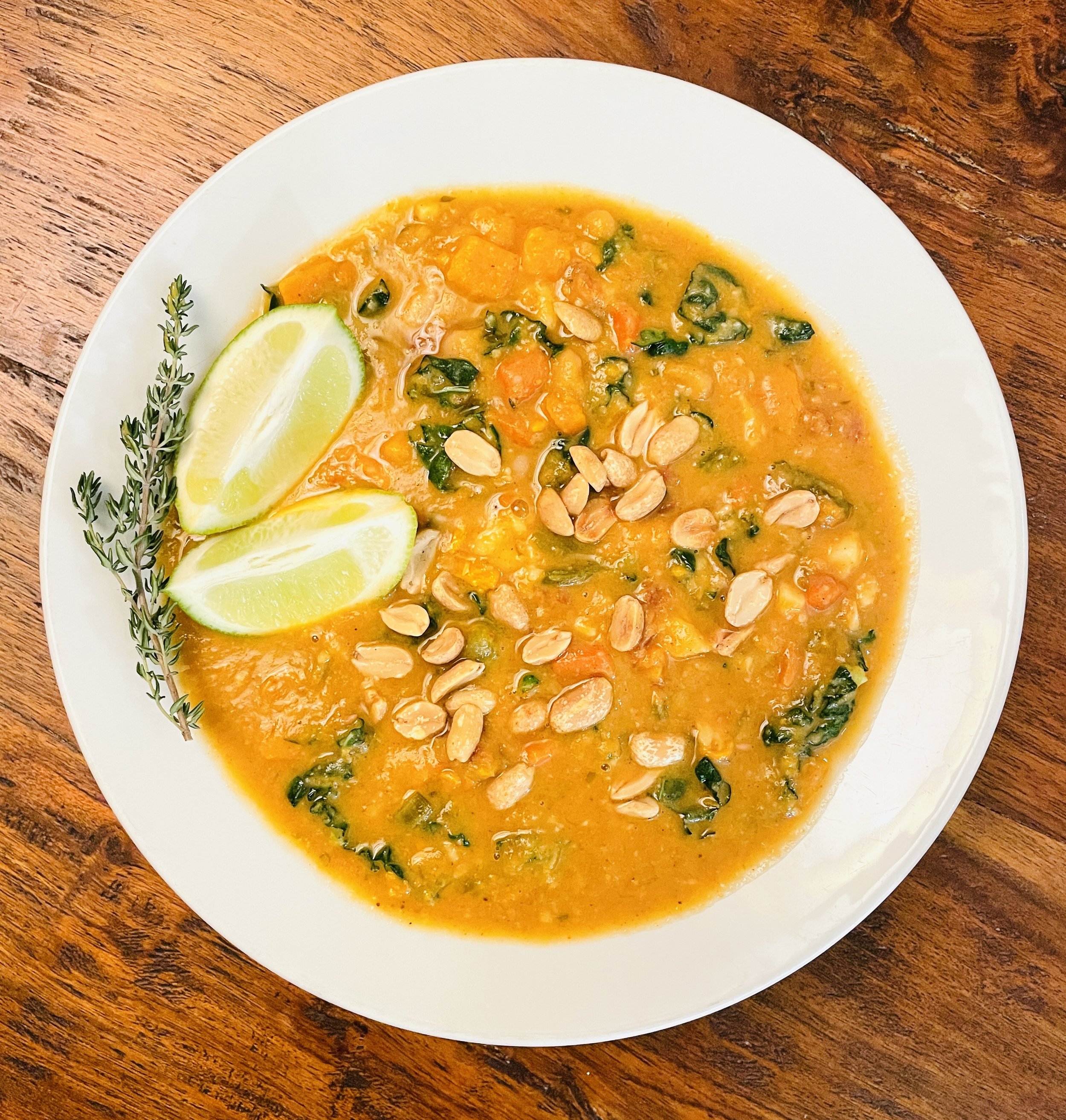Gambian Peanut Stew
Recipe adapted from Nisha Vora at Rainbow Plant Life
This is another scrumptious recipe from one of my all-time favorite plant-based chefs, Nisha Vora at Rainbow Plant Life. If you haven’t met her before, I encourage you to pop over to her website https://rainbowplantlife.com for some amazing plant-forward cooking inspiration.
It was cold outside, so I needed something warm, filling, and spicy. This Gambian Peanut Stew was just the ticket. To increase the plant variety, in addition to the ingredients called for her in her recipe, I also added in carrots and celery, used both lemons and limes, and included two kinds of sweet potatoes (red garnet and Japanese). This pot of delicious soup had 19 different plants, including a wide range of nutritional powerhouses such as beans, nuts, leafy greens, non-starchy veg, alliums, citrus, and a variety of spices. When cooking a recipe, I often see where I can sneak in a few extra veggies to increase the plant variety for optimal microbiome health.
I also included a splash of tamari for added umami and a squirt of sriracha for added heat. I made this in the pressure cooker, as she offers as an option, and it was quick, easy, and totally delicious. Plus, it made a ton of leftovers for lunches. Yay!
Special Equipment Needed: Pressure Cooker
Ingredients:
One large onion, chopped.
(I didn’t have an onion on hand, so I used scallions instead. Any alliums will do.)5-6 medium carrots, peeled and chopped into bite-sized pieces
2 stalks celery, finely chopped
2-6 cloves of garlic, pressed or finely minced
(Pick the number of cloves to match your garlic preference.)2 tablespoons (approximately 2 inches) of freshly grated ginger
(Freezing the knob of ginger beforehand makes this job much easier. There is no need to peel the ginger first. The peeling is edible, and leaving it on saves time and adds fiber to your dish.)1 1/2 teaspoons ground cumin
1 teaspoon ground coriander
1 teaspoon ground turmeric
1/4 teaspoon cinnamon
1/4 teaspoon ground cloves
1 teaspoon salt
1/2 teaspoon black pepper
4 cups vegetable broth
(Use your favorite stock. I used four cups of water with 4 Massel’s 7 stock cubes.)1-2 jalapeno peppers, finely diced (Depending on your spice preferences.)
1 15-ounce can chopped tomatoes
4 sweet potatoes, peeled and finely chopped
(I used a combination of red garnet and Japanese)1 15-ounce can of white beans, rinsed and drained
(Canellini, great northern, or garbanzo beans all work well).1/2 cup of creamy natural peanut butter (no sugar added)
1-2 tablespoons of tamari
Handful of fresh thyme, woody stems removed
Added after cooking:1 bunch of kale, ribs removed and chopped
The juice of one lemon
The juice of one lime
For serving (optional):
Chopped cilantro
Chopped dry-roasted peanuts
Sriracha
Brown rice, quinoa, millet, or your whole grain of choice
Method:
Add the onion, celery, and carrots to your instant pot with a splash of water.
Select the sauté setting.
Water sauté on high until the aromatics are cooked through and starting to caramelize.
Add in the garlic, ginger, and your ground spices. Cook for 30 seconds until fragrant.
Add in the vegetable stock and deglaze the pan, fully scraping up any browned bits on the bottom of the pan.
Cancel the sauté setting.
Add in your remaining ingredients through the fresh thyme.
Stir well and securely attach the pressure cooker lid.
Cook on high pressure for 5 minutes.
Release the steam, open the lid, and add in your chopped kale.
Return the lid and allow the kale to soften in your hot soup for approximately five minutes.
Just prior to serving, squeeze in the juice of both the lemon and lime. Stir well to incorporate.
Taste and adjust your seasonings, adding in more tamari or a squirt of sriracha, as desired.
Serve with optional chopped cilantro, dry-roasted peanuts, and sriracha.
For a heartier meal, serve this over the whole grain of your choice.
Pro Tip:
Before I started prepping all my veggies, I increased the nutrient density by using Dr. Michael Gregor’s “whack and wait” or “hack and hold” technique of chopping the kale at least 40 minutes before cooking or eating it. Cutting cruciferous veggies and waiting to cook them allows the Sulforaphane levels in the food to rise. This technique is described in his must-read book, How Not To Die. www.thewell-nourishedbrain.com/blog/resources
Sulforaphane is an organic compound found in cruciferous and brassica veggies, like broccoli, cauliflower, cabbage, kale, Bok choy, and Brussel sprouts. It is a powerful antioxidant with anti-inflammatory benefits and anti-cancer potential. Sulforaphane boosts the liver’s detoxifying enzymes, and it helps to protect our brains, eyesight, and cardiovascular systems. It has anti-aging effects, helping to combat free radical damage, aiding in wound healing, and limiting the loss of collagen as we age (think wrinkle reduction). It has been shown to reduce viral load in human clinical trials. It can even reduce the effects of asthma, aid in diabetes, and improve the symptoms of autism. Basically, Sulforaphane is a nutritional badass.
To maximize the Sulforaphane in your foods, it is easy to just chop your cruciferous veg first. As you prep the other ingredients, the sulforaphane levels will rise increasing the nutrient density of your meal. Magic!
Yield: 6 two-cup servings, without optional dry-roasted peanut topping
Nutrition Information per each 2-cup serving:
Calories: 419 Protein: 16.5 g Fat: 16.8 g Carbs: 44.3 g Fiber: 14.3 g Iron: 3.2 mg
Calcium: 172.2 mg Vitamin A: 1551 IU Vitamin C: 54.3 mg Folate: 98.5 IU
Potassium: 1376 mg Polyunsaturated Fat: 2.5 g Saturated Fat: 2 g
Trans Fat: 0 g Cholesterol: 0 mg
I encourage you to give this fabulous recipe a try and to check out Nisha’s great videos at www.youtube.com/@RainbowPlantLife.
She has terrific cooking tutorials, if you like to follow along as you cook.
Thank you, Nisha!
Eating for health is delicious!
🌱💕





